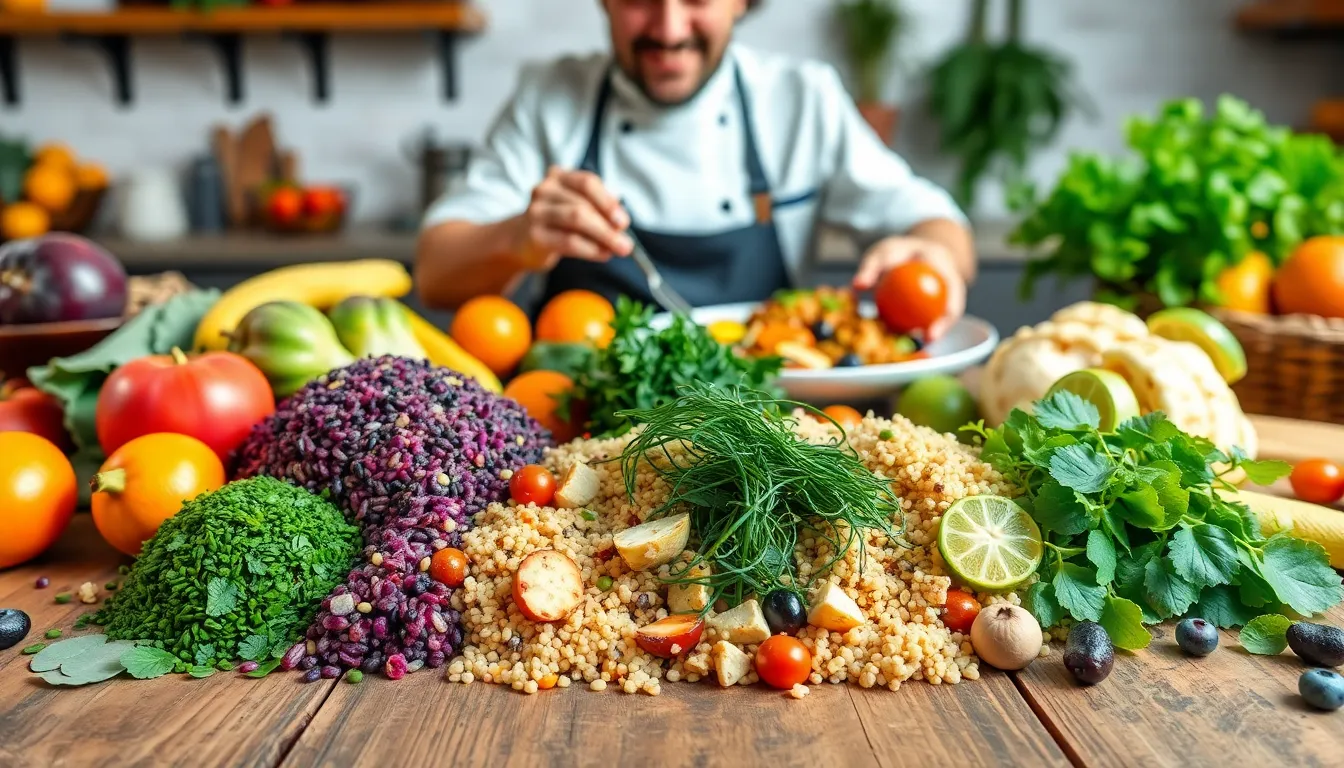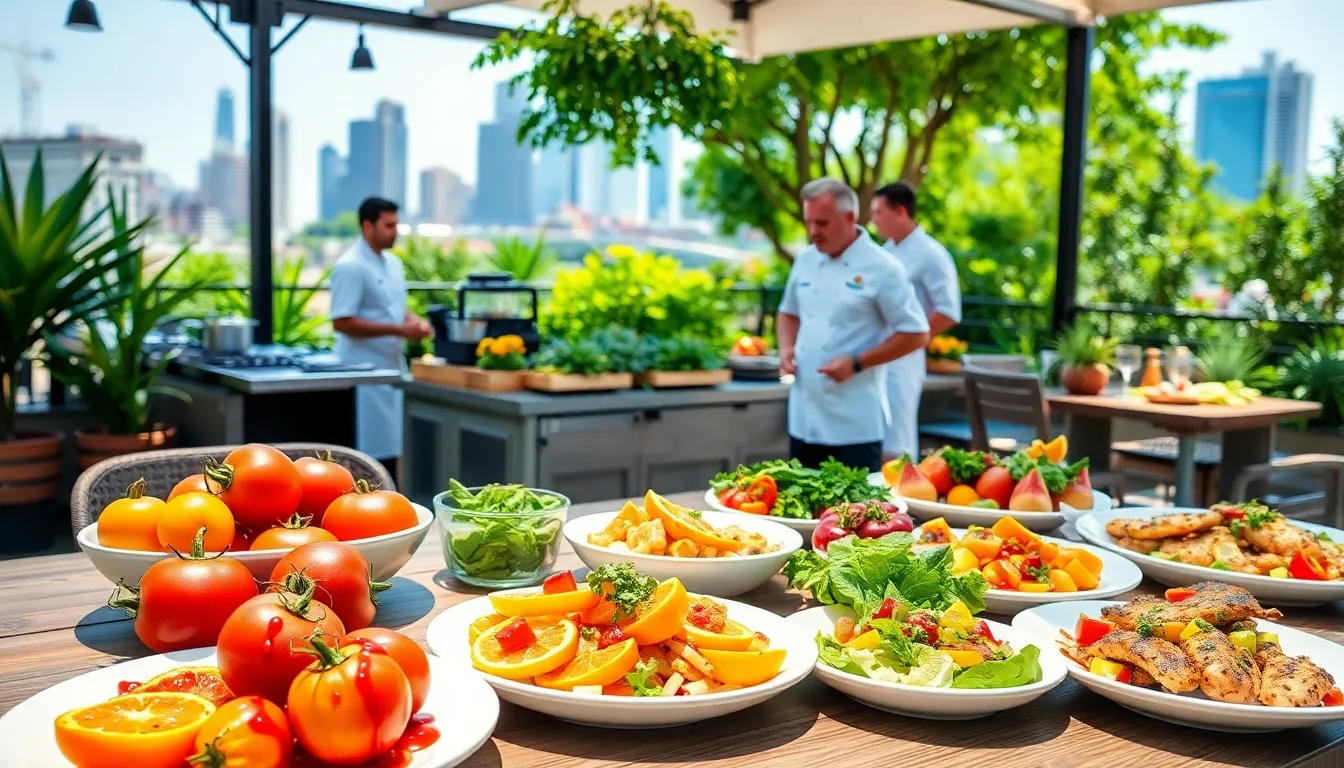Table of Contents
ToggleIn a world where food is more than just fuel, culinary trends are shaking things up like a well-mixed cocktail. From plant-based delights to the rise of global flavors, today’s dining scene is a delicious playground for adventurous eaters. Who knew that kale could be so cool or that fermented foods would become the new black?
Overview of Culinary Trends
Culinary trends shape the way people approach food and dining experiences. Plant-based diets continue to gain traction as more individuals seek healthier lifestyle choices. With the rise of vegetarian and vegan options, kale and other leafy greens often feature prominently on menus.
Global flavors influence culinary styles as chefs experiment with diverse ingredients and techniques. Traditional cuisines from regions like Southeast Asia and the Mediterranean attract attention, leading to innovative fusion dishes. Fermented foods, including kimchi and sauerkraut, enhance flavor profiles while offering health benefits.
Sustainability remains a significant focus within culinary trends. Consumers now prefer locally sourced ingredients, reducing environmental impact. Many restaurants highlight seasonal produce, supporting local farmers while enhancing freshness.
Health-conscious eating is on the rise, prompting an increase in gluten-free, low-carb, and paleo options. Moreover, convenience plays a role in culinary adaptations, with meal kits and on-demand delivery services becoming popular. These developments cater to busy lifestyles while maintaining quality.
Ethical dining practices attract attention as customers seek transparency regarding ingredient sourcing. Awareness around food waste encourages restaurants to adopt creative ways to utilize every part of an ingredient. Approaches such as nose-to-tail and root-to-leaf cooking emphasize resourcefulness and innovation.
These culinary trends create a dynamic landscape, continually evolving based on consumer preferences and environmental considerations. Chefs and food enthusiasts alike embrace change, crafting unique experiences that reflect a broader understanding of food and its cultural significance.
Emerging Ingredients

Emerging ingredients are redefining culinary landscapes. These ingredients cater to evolving consumer preferences while innovating traditional dishes.
Superfoods
Superfoods dominate culinary conversations due to their nutritional benefits. Ingredients like quinoa, spirulina, and jackfruit are favorites among health-conscious eaters. Quinoa offers high protein levels, making it a staple in many plant-based diets. Spirulina, rich in vitamins, is often incorporated in smoothies and juices. Jackfruit serves as a meat substitute in various dishes, appealing to those following vegan lifestyles. The accessibility and versatility of these superfoods drive their popularity, while chefs creatively integrate them into mainstream cuisine.
Unusual Flavor Combinations
Unusual flavor combinations spark curiosity and excitement among diners. Pairings such as chocolate with chili and strawberry with balsamic vinegar create surprising taste experiences. Chefs experiment with these contrasts to enhance depth and complexity in dishes. For instance, spicy-sweet profiles in sauces and glazes showcase new culinary techniques. Umami elements, like fermented foods with fruit, also catch the attention of adventurous eaters. These innovative pairings enhance the overall dining experience, encouraging patrons to explore beyond traditional flavor boundaries.
Sustainable Practices
Sustainable practices are reshaping how consumers approach food and dining experiences. Emphasis on eco-friendly and ethical solutions drives the culinary industry forward.
Farm-to-Table Movement
Farm-to-table emphasizes fresh, local ingredients in culinary creations. Chefs source produce directly from nearby farms, ensuring quality and supporting local agriculture. This movement cultivates relationships between consumers and producers, enhancing the dining experience. Diners enjoy seasonal flavors that reflect the regional character. By prioritizing local sourcing, restaurants reduce transportation emissions and boost the local economy.
Reducing Food Waste
Reducing food waste is becoming a priority in modern kitchens. Chefs focus on utilizing all parts of ingredients, transforming scraps into flavorful dishes. Many establishments implement creative practices like composting and portion control to minimize waste. By repurposing leftovers, culinary teams contribute to sustainability while maximizing resources. Consumers increasingly seek out restaurants with transparent waste reduction strategies, aligning dining choices with ethical values.
Global Influences
Global culinary influences are shaping modern dining experiences, blending cultures and traditions into unique dishes. Diverse flavors and innovative techniques now inspire chefs worldwide.
Fusion Cuisine
Fusion cuisine combines elements from different culinary traditions, creating exciting and unexpected dishes. This approach allows chefs to integrate ingredients and cooking methods from various cultures. Patrons often encounter combinations like Korean tacos or sushi burritos. Diners appreciate the adventurous spirit of fusion, as it expands their palates and introduces them to global flavors. Restaurants frequently showcase these creations on their menus, appealing to a diverse clientele eager for unique culinary experiences.
Traditional Cooking Techniques Revived
Reviving traditional cooking techniques has become increasingly popular among chefs. Many are revisiting methods such as fermentation, smoking, and pickling, which add depth to contemporary dishes. By incorporating these age-old practices, chefs honor culinary heritage while creating modern interpretations. Home cooks also experiment with these techniques, leading to a resurgence of interest in the art of cooking. Embracing these methods supports a farm-to-table ethos, emphasizing the importance of quality ingredients and preserving food traditions.
Technology in the Kitchen
Technology revolutionizes the cooking experience, fostering convenience and innovation in culinary practices.
Smart Cooking Gadgets
Smart cooking gadgets enhance kitchen efficiency. Devices like instant pots and air fryers simplify meal preparation, reducing cooking times significantly. Precision scales aid in accurate ingredient measurements, while smart thermometers ensure perfect doneness consistently. Multiple appliances now integrate with apps, offering recipe suggestions and cooking tips tailored to individual preferences. Equipped with voice-activated features, these gadgets support hands-free cooking, making it easier to multitask in the kitchen. Adopting these tools allows home chefs to experiment and create dishes with confidence.
Online Cooking Classes
Online cooking classes provide opportunities for culinary skill development. Platforms like MasterClass and Udemy offer courses in various cuisines, led by expert chefs. Students of all levels can engage in interactive formats that include video tutorials and live Q&A sessions. Learning new techniques online empowers home cooks to elevate their cooking game at their own pace. Community forums foster collaboration, allowing participants to share experiences and tips. Accessibility of these classes promotes continuous learning and experimentation in the kitchen, enhancing overall culinary knowledge.
Culinary trends are reshaping the dining landscape in exciting ways. As consumers become more health-conscious and environmentally aware, their preferences are driving chefs to innovate. The fusion of global flavors and traditional techniques invites adventurous eating experiences, while the focus on sustainability and local sourcing reinforces the connection between food and community.
Moreover, technology continues to enhance culinary practices, making cooking more accessible and enjoyable. This dynamic evolution not only reflects changing tastes but also emphasizes the importance of food’s cultural significance. With these trends, the culinary world is poised for a vibrant future that celebrates creativity and responsibility.




